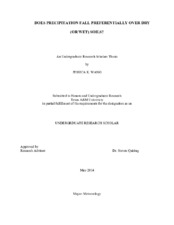| dc.creator | Wang, Jessica Ka Main | |
| dc.date.accessioned | 2020-05-27T20:46:56Z | |
| dc.date.available | 2020-05-27T20:46:56Z | |
| dc.date.created | 2014-05 | |
| dc.date.issued | 2013-10-03 | |
| dc.date.submitted | May 2014 | |
| dc.identifier.uri | https://hdl.handle.net/1969.1/188025 | |
| dc.description.abstract | Previous work suggests precipitation is more likely to fall over dry soils than wet soils. The limited knowledge of the association between surface moisture content and convective activity raises many questions about whether a positive (or negative) feedback exists. A positive feedback implies higher soil moisture values correspond with enhanced precipitation. While soil moisture does not directly influence precipitation, it does moderate latent and sensible heat fluxes, which may lead to influencing convective initiation. In this study we analyze synoptically benign (SB) environments that do not feature a low-level jet (noLLJ). Because these atmospheric conditions are expected to be much less conducive to convection and precipitation, we can better understand the possible impacts of soil moisture. This case study approach will focus on convective events that are characterized as localized convective precipitation as opposed to stratiform precipitation caused by large-scale frontal systems. Convective initiation was found to occur over relatively dry soils largely influenced by sensible and latent heating and consequently increasing atmospheric instability leading to convection. | en |
| dc.format.mimetype | application/pdf | |
| dc.subject | soil moisture | en |
| dc.subject | land-atmosphere interactions | en |
| dc.title | Does precipitation fall preferentially over dry (or wet) soils? | en |
| dc.type | Thesis | en |
| thesis.degree.department | Atmospheric Sciences | en |
| thesis.degree.discipline | Atmospheric Sciences | en |
| thesis.degree.grantor | Undergraduate Research Scholars Program | en |
| dc.contributor.committeeMember | Quiring, Steven | |
| dc.type.material | text | en |
| dc.date.updated | 2020-05-27T20:46:56Z | |


